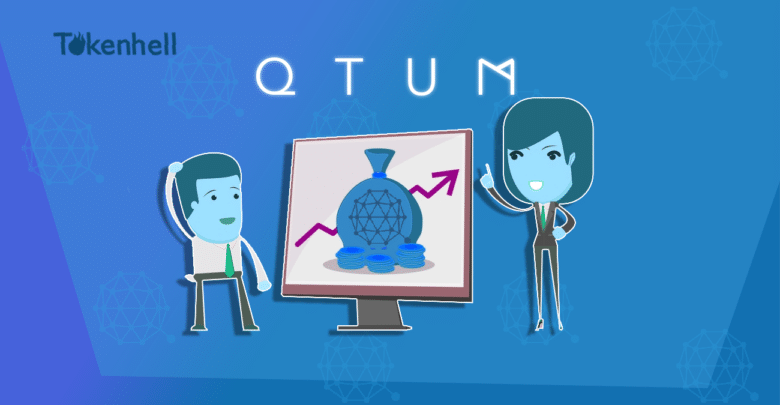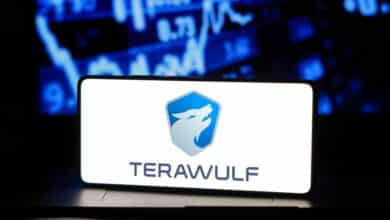
With the dawn of decentralization and blockchain technology getting more sophisticated and drawing real-world uses here and there, multiple cryptocurrencies came into begin. With a lot of options to choose from, the financial enterprises truly began to grab whatever they deemed fit or whichever cryptocurrencies aligned best with their business motives.
Today you will be able to find tons of cryptocurrencies out there with different consensus algorithms and different purposes under the hood. Some are true to be used in the spirit of being a financial entity; others help with the issues of scalability and interoperability, while some only deal with governance. There are a lot of options indeed, but today we will specifically be talking about the Qtum (QTUM).
Qtum is a blockchain system that was introduced to the world in 2016. It has done a fantastic job combining the smart contract capabilities of the Ether with the UTXO accounting system from the Bitcoin network. This marvelous unification from both networks can be implemented by the Qtum with the help of the account abstraction layer; using this amazing technology, Qtum is able to roll out updates towards its main network directly from the Bitcoin and Ether. The entire system is decentralized, which means that you don’t have to ask for someone’s permission to be able to validate transactions, conduct transactions, or run a node onto the network. Anyone with access to the internet can do so.
The process of incentivizing the validators or miners over the network is also revitalized as the Qtum uses mutualized proof of stake consensus algorithm, which allows multiple miners to take part in the validation of a single transaction while the reward is then split into multiple parts, which are then equally distributed among these miners.
The network extends support for various types of tokens out there, originating from different backgrounds and using different cryptographic systems. The QTUM, which is the native cryptocurrency of the network, can be used for the sake of validating transactions, staking the token in either an online or offline array, or for you to trade it over a crypto exchange of your liking. There is a lot that can be done over the Qtum network; more information is below;
What is Qtum?
Qtum is a decentralized entity with a single purpose to follow, and that is to combine different elements from both Ether and Bitcoin through a specific technology that the network has developed. The unspent transaction output model has been taken from Bitcoin, and it was later on combined with Ether’s smart contract model, which allows Qtum to leverage all the splendid benefits from these two utterly different decentralized enterprises.
Working of Qtum
Now that you have heard about how the cryptocurrency leverages the technology of both Bitcoin and Ether, you must be wondering how Qtum does work and what is in it for you? To make the whole deal a bit easier for you, here are the four dynamic parts of the Qtum network;
- The establishment of the UTXO model for the sake of accounting
- A smart contract platform based on solidity
- An account abstraction layer
- Proof of stake consensus mechanism to bind the whole deal together
A modified bitcoin core client software is being used by Qtum for the sake of completing or building the transaction base for the network. This network has also been given the authority to dangle with Ether, and therefore it is strictly kept EVM or compatible with the Ether enterprise as an Ether virtual machine.
The whole enterprise now uses Solidity as the base coding language to make things easier and more streamlined because if a common coding language was to be used for such an esteemed process, then things would have been less unique while giving out the feeling of being stuffed. You have complete authority when it comes to importing any sort of code as well as the smart contract capabilities of Ether right over to the Qtum. The proof of stake consensus algorithm works as a cherry on top for the whole enterprise as it ensures smooth and efficient tackling of all the pertaining security issues for the network in question.
What are UTXOs?
The unspent transaction outputs or the UTXOs are pretty common but, at the same time, a unique concept in the realm of decentralization; without it, the concept of transactions taking place in a decentralized manner would have been utterly difficult. The outputs and inputs are the sourcing elements for whatever transaction is being commenced on whichever network.
Taking an example into account, if you want to send some BTC to one of your friends or some other interested party, then you would have to use the UTXO as an input but then transfer the whole deal into the output right before you are all but ready to click that send button.
When you have sent the transaction or completed it from your end, then the UTXOs that you did use would be labeled as completely spent. Now your output is going to become or get shifted into a new UTXO. You might not be able to grasp the ingenuity of this system at first, and it might also come out as plainly odd, but at its core, this system does have its own benefits that it brings to the table. Some of these benefits are as follows;
- You would be able to tackle double spending much more easily, which is a cruel problem over the Bitcoin network, and even after many patches, the problem still persists. You would be able to negate double-spending as you would be able to see if the output in question has been already spent or not.
- Every transaction consists of independent outputs, which means that the network is able to process each and every transaction in parallel, decreasing the waiting period and making sure that the transactions are validated rather promptly.
Ether, on the other hand, uses the same model as a conventional financial bank for the sake of tracking the balances of many users and all accounts present on the network. This is also a step taken to ensure that the malicious activity taking place over the network could be controlled and the hard-earned money of the people or the tokens of the users are not only secure, but their data/information is updated in real-time to avoid all kinds of errors.
Account Abstraction Layer
The blockchains out there that have enabled the smart contract capacity usually don’t sit well with the UTXO accounting system, and that is because they have their own designated technologies working in the background, taking care of the stuff. Another reason is technical difficulties and the lack of interoperability when it comes to sharing data or smart contracts to and from different blockchain mediums out there. That is why Qtum has come forward with the account abstraction layer as the plausible answer to this problem. This allows for the abstraction of the Ether’s account system from the technical implementations that it has for it to work properly without any kind of errors or stuff.
Here smart contracts are not recognized by their hash remodeling over the blockchain but are recognized via their address over the blockchain or the end balance that they carry. But if a smart contract is to work without any errors with a UTXO, then it has to choose what specific UTXO it wants to pair with, and that must happen along the entirety of both public and private addresses over the blockchain functionality.
There exists a similar problem when we take into account the internal transactions taking place between these contracts in question. UTXO blockchain, when paired with such smart contracts, is put in charge of sourcing all the data that is present over the blockchain media for the transactions that are taking place, but this thing excessively complicates the whole process rather than making it any easier. This is where the account abstraction layer is put to good use. It works by noting down the UTXO transaction’s output and then developing a smart contract around it, the contract in itself carries the complete information about the transaction, which specific UTXO protocol was used, and all that pertaining information that is necessary for its timely execution.
After this smart contract has been developed, the AAL (account abstraction layer) will then send the transaction to the said contract account for the sake of triggering the execution of this particular contact. The AAL then processes the result in a fine manner while making it adapt to the UTXO standard. It is a bit lengthy process, but at the end of the day, it is not only worth it but saves the developers a lot of complications when it comes to validating the transactions and keeping the integrity of the network intact.
The AAL technology is at the very heart of how Qtum operates and just how well. It allows the technology to be able to take solemn advantage of both Bitcoin and Ether updates. It means that whenever a new update is made available to any cryptocurrency, the Qtum just updates itself and gets early access to these changes. When Ether was finally given the courtesy to orchestrate and develop the smart contracts, the Qtum was able to adopt this change right then and there.
With a lot of updates for Bitcoin and other flagship cryptocurrencies being made available, Qtum will be able to not only adopt and intercept all these updates but will also be able to use whatever specific privileges these updates carry on its own unique network from the very first day. Qtum is finally benefiting not only from the lightning network but also from other such technologies that are present either on Ether or the Bitcoin or both.
Consensus Mechanism of Qtum (QTUM)
There is the proof of stake consensus mechanism, and then there is the mutualized proof of stake consensus. The proof of stake consensus works by allowing multiple validators to take part in the validation of the transaction, but for them to become legitimate validators within the network, they have to stake a proportionate share of tokens, or otherwise, they won’t be able to do so.
Mutualized proof of stake consensus is mainly the invention of the Qtum technologies, and it is the custom consensus mechanism. The very purpose of this specialized type of consensus mechanism was to battle the junk contract spam attacks initiated by the hackers for the sake of increasing the final cost of the token in itself. This mechanism allows the sharing of the block reward among the nodes which are put in charge of transaction validation, but in doing, so, it also delays the payments substantially. Each and every reward that is to be distributed gets split into equal parts and is then awarded to the successful validator of the present transaction going all the way back to the other nine validators that have been working in harmony and in a linear chain structure.
As you can see, the other nine validators who did submit their blocks a long time ago are only awarded the latest validator, thus delaying the payments as orchestrated by the consensus algorithm in question. A portion of the reward is then further delayed for the other 500 blocks that are yet to come. This system is put in charge for the sake of confusing the attackers to their extreme because this way, they won’t be able to calculate the extra rewards that have been rewarded to the validators.
Because this is the kind of information, they should have at hand if they want to launch a successful attack over the network. The other consensus algorithms out there serving different cryptocurrencies are doing nicely, but this added layer of security that the mutualized proof of stake consensus algorithm puts forward is something else entirely; it is much more efficient and secures while at the same time interoperable between multiple ecosystems and crypto networks out there.
Qtum’s Offline Staking
You might have heard about the term staking; it is the process in which you stake away some of the crypto tokens representing a particular blockchain system for a general period of time only to get rewards and all sorts of compensations for the time period these tokens remained in a staked state. Now, this is pretty much how staking works, but offline staking is a completely new concept brought to you by Qtum technologies.
This is a new mechanism system employed by Qtum for the users who have some QTUM token at hand and want to make a handsome amount of money through it. What needs to be done here is that instead of giving the custody for your QTUM tokens and staking these for the sake of getting rewards and whatnot from the network you are instructed to give away only your wallet address where these QTUM tokens reside. This way, the tokens will actually stay within your wallet and can be used any time by you; it is kind of nice given the fact that you won’t have to deal with the prospect of giving away the full custody of your QTUM tokens; hence rendered from using these until unless the staking period is over. The mechanism can be divided into two sectors based on the functionality, such as the super stakers and the validators.
So, the people who actually have the tokens at hand within their wallets can send the request of delegation to the super stakers out there. These are the people who would be staking away these tokens on behalf of the delegators, and when they have successfully validated a transaction, they will have to share the block reward with their particular delegator. The process is not only simple but much more efficient this way, but for the delegator to be able to receive the prospects from the reward, they will also be charged a fee from the super stakers because, in reality, these are the people who are doing all the heavy lifting for the delegators.
You would continue to passively earn the QTUM tokens once you have developed a partnership with a super staker. You won’t have to enroll yourself into a smart contract or any decentralized contract of any sort because you are not actually giving away your tokens but merely the address of the wallet in which these tokens reside.
If you deem it well, then you can take out your tokens from your online wallet into a hardware wallet and let the super staker have access only to the address of your online wallet and nothing else. This way, you won’t be worrying about having to give away your tokens or being locked into an agreement of any sort. The Qtum technologies and blockchain system is really the next generation worthy prospect in the crypto world as the solutions the crypto enterprise is bringing forward are not only tempting but eccentrically charming as well.
Tokenhell produces content exposure for over 5,000 crypto companies and you can be one of them too! Contact at info@tokenhell.com if you have any questions. Cryptocurrencies are highly volatile, conduct your own research before making any investment decisions. Some of the posts on this website are guest posts or paid posts that are not written by Tokenhell authors (namely Crypto Cable , Sponsored Articles and Press Release content) and the views expressed in these types of posts do not reflect the views of this website. Tokenhell is not responsible for the content, accuracy, quality, advertising, products or any other content or banners (ad space) posted on the site. Read full terms and conditions / disclaimer.







